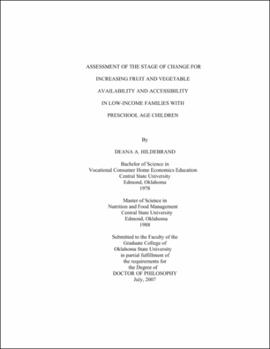| dc.contributor.advisor | Betts, Nancy M. | |
| dc.contributor.author | Hildebrand, Deana A. | |
| dc.date.accessioned | 2013-11-26T08:26:19Z | |
| dc.date.available | 2013-11-26T08:26:19Z | |
| dc.date.issued | 2007-07 | |
| dc.identifier.uri | https://hdl.handle.net/11244/6860 | |
| dc.description.abstract | Scope and Method of Study: In light of increased dietary intake recommendations and pending changes to federal food assistance programs aimed at increasing fruit and vegetable consumption, our interest was in determining the intent of parents and caregivers of preschool age children for making available more fruit and vegetable, and identifying differences between those already serving adequate amounts and those who were not. Data for the cross-sectional, quantitative study came from 238 low-income parents/primary caregivers of preschool age children. We utilized the Transtheoretical Model of Behavior Change to assess the psychosocial factors of decisional balance, self-efficacy and processes influencing availability and accessibility of fruit and vegetable. A two-stage algorithm was used for staging respondents into stages of change, and an eight item fruit and vegetable frequency survey was used to determine the availability of fruit and vegetable accessible to children. Analyses of variance were used to compare differences between stages on each of the constructs and fruit and vegetable availability. | |
| dc.description.abstract | Findings and Conclusions: Our findings lend evidence that low-income PPC of preschool age children were in different stages of change for increasing availability of fruit and vegetable to their preschool age children. Children of PPC in preparation and action stages had significantly greater availability of whole fruit, dark green vegetables and other vegetables. Availability of 100% juice, orange vegetables and starchy vegetables was similar for all stages. PPC in preaction stages had a negative decisional balance related to cost and time to prepare fruit and vegetable compared to PPC in preparation and action stages. Self-efficacy, especially preparing fruit and vegetable acceptable to families, increased as stage and availability increased. PPC in action stages more frequently employed a variety of strategies to make fruit and vegetable available, particularly the behavioral process of countering by serving fruit and vegetable for snack instead of less nutritious foods. As such, the constructs of TTM have practical applications in nutrition education efforts aimed at increasing fruit and vegetable availability and accessibility in low-income households with preschool age children. | |
| dc.format | application/pdf | |
| dc.language | en_US | |
| dc.rights | Copyright is held by the author who has granted the Oklahoma State University Library the non-exclusive right to share this material in its institutional repository. Contact Digital Library Services at lib-dls@okstate.edu or 405-744-9161 for the permission policy on the use, reproduction or distribution of this material. | |
| dc.title | Assessment of the stage of change for increasing fruit and vegetable availability and accessibility in low-income families with preschool age children | |
| dc.contributor.committeeMember | Gates, Gail | |
| dc.contributor.committeeMember | Kennedy, Tay S. | |
| dc.contributor.committeeMember | Parker, Stephany | |
| dc.contributor.committeeMember | Warde, William D. | |
| osu.filename | Hildebrand_okstate_0664D_2354.pdf | |
| osu.accesstype | Open Access | |
| dc.type.genre | Dissertation | |
| dc.type.material | Text | |
| dc.subject.keywords | nutrition | |
| dc.subject.keywords | children | |
| dc.subject.keywords | low-income | |
| dc.subject.keywords | stage of change | |
| dc.subject.keywords | fruit and vegetable | |
| dc.subject.keywords | transtheoretical model | |
| thesis.degree.discipline | Human Environmental Sciences | |
| thesis.degree.grantor | Oklahoma State University | |
